‘Reaching for the sky’: the pioneering aeronauts of the DUA
Ian Blair
In the formative early years of the DUA, most notably on Trig Lane (TL74), the ability to gain altitude to take aerial photographs was a problem that was overcome in a variety of ingenious, if now deemed ever-so-slightly unsafe ways.
Interestingly, it does not appear that erecting a scaffold tower on top of the beautifully constructed Trig Lane Ziggurat (one of the Seven Wonders of the DUA) was one of them, or maybe this too was tried but photographic evidence has yet to surface.
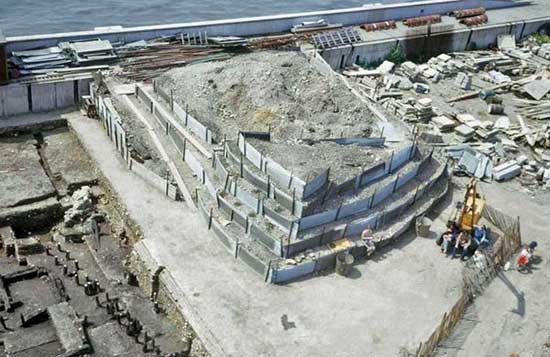 ‘The Trig Lane Triggurat’: One of the Seven Wonders of the DUA. Photo: Jamie Muir
‘The Trig Lane Triggurat’: One of the Seven Wonders of the DUA. Photo: Jamie Muir
The favoured method used to gain elevation on Trig Lane appears to be the ‘man in a skip-bucket’ suspended from the jib of a mobile crane parked on the edge of the excavation. In the first two photos Jamie Muir can be seen on the flightdeck manning the controls, with Alan Thompson stood alongside with one foot planted firmly on the back wheel of the crane, an action unlikely to have been undertaken in the interests of rudimentary health and safety, or to add a modicum of extra weight and act as a counterbalance to prevent the crane from toppling over into the trench.
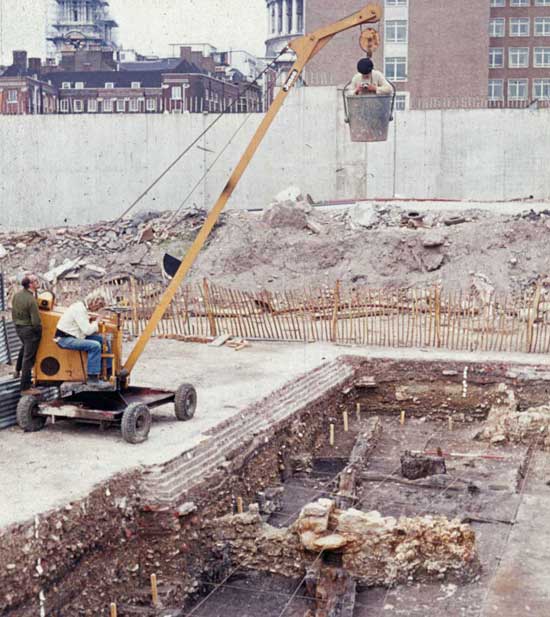
Houston we have lift off! Jamie Muir at the controls, Alan Thompson acting as ballast, and archaeologist/photographer Graham Troillet (Houghton) captured mid-flight Photo: ©MOLA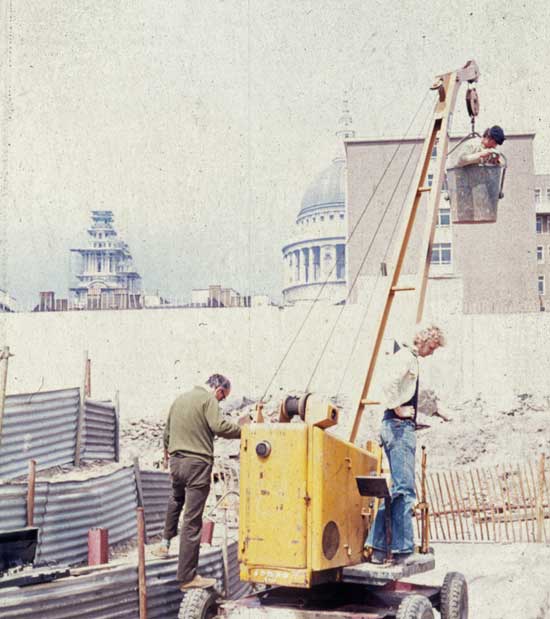
The photos had clearly been taken on two separate occasions and although it initially appeared as if more than one photographer may have featured in the skip-bucket, we are now of the opinion that all in fact are of archaeologist/photographer Graham Troillet (Houghton).
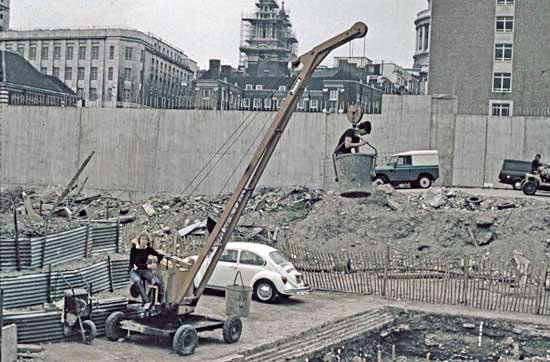 Jamie Muir swings Graham Troillet (Houghton) into position. Nice looking Volkswagen Beetle in the background – I wonder who owned that? Photo: ©MOLA
Jamie Muir swings Graham Troillet (Houghton) into position. Nice looking Volkswagen Beetle in the background – I wonder who owned that? Photo: ©MOLA
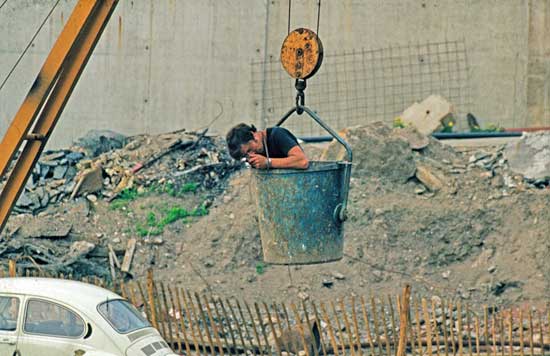 Airborne archaeologist/photographer Graham Troillet (Houghton) zooming in on Trig Lane Photo: ©MOLA
Airborne archaeologist/photographer Graham Troillet (Houghton) zooming in on Trig Lane Photo: ©MOLA
It is clear however that supplementary rides were also given to non-photographers as illustrated by the photo of a slightly pensive-looking Mark Harrison seen dangling in the bucket at the top of the crane jib. Mark was the original DUA site supervisor on Trig Lane in the early years before Gustav Milne climbed into the saddle and took hold of the reins.
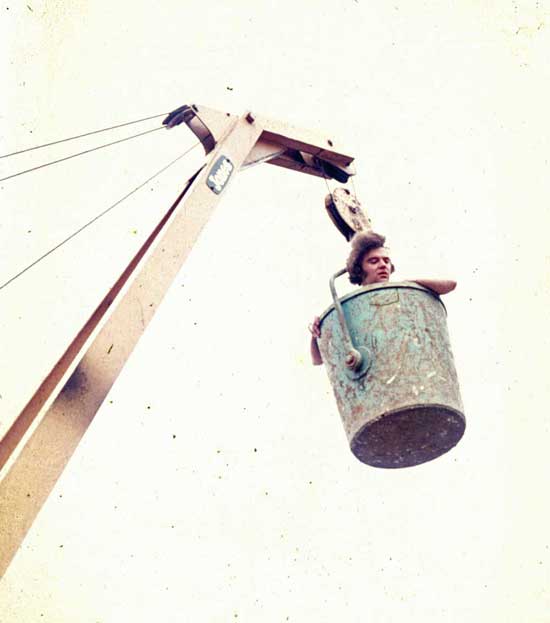 Trig Lane Supervisor Mark Harrison takes to the air to survey his early kingdom Photo: ©MOLA
Trig Lane Supervisor Mark Harrison takes to the air to survey his early kingdom Photo: ©MOLA
Despite its clear advantages over photographs taken from the surface, there were still limitations height-wise with the ‘man in a skip-bucket’ approach, so other avenues had to be explored to gain even greater elevation, so cue a fire engine. My jaw drops open every time I look at the following photos and I wonder how on earth you manage to procure a fire engine: do you simply wander down to the nearest fire station and talk to the person in charge:
‘Yes, that’s right, we are archaeologists working on an excavation down the road and we need to borrow one of your fire tenders with its extending ladder to take some aerial photos’ - then adding: ‘Rest assured that the person taking the photographs has a very good head for heights and will hang on tightly to the ladder, maintaining three points of contact with the ladder at all times, whilst pressing the camera shutter release with his nose!’.
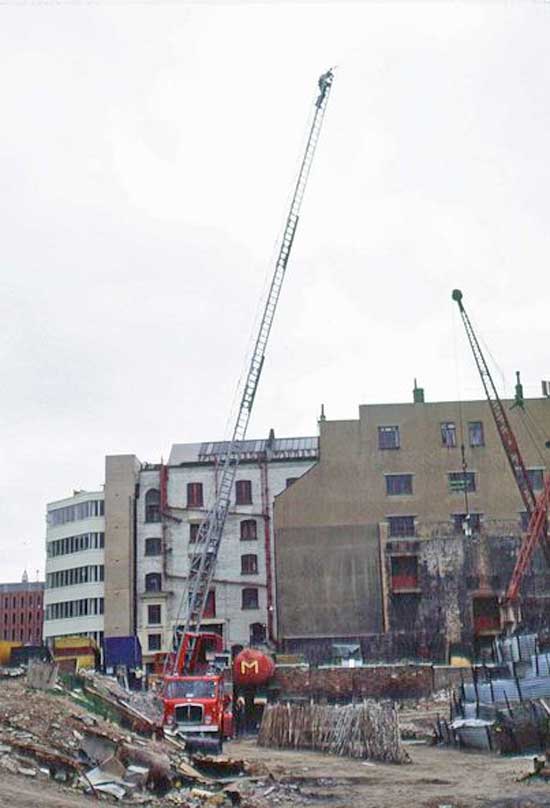 Rising to even greater heights No.1: Jamie Muir at the top of Fire engine ladder (looking east) Photo: Jamie Muir
Rising to even greater heights No.1: Jamie Muir at the top of Fire engine ladder (looking east) Photo: Jamie Muir
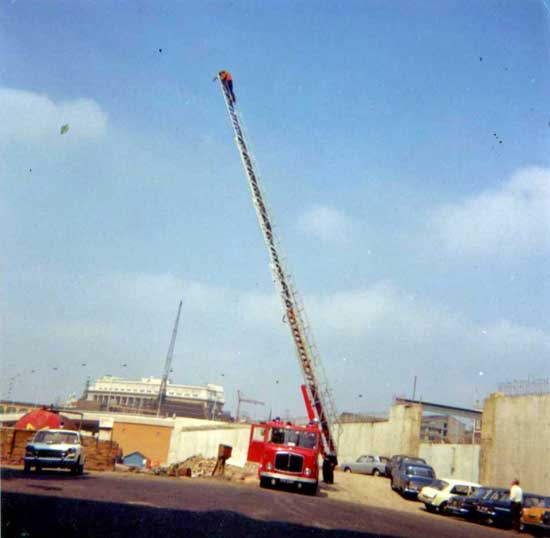 Rising to even greater heights No.2: Mark Harrison at the top of Fire engine ladder (looking west) Photo: Charlotte Harding
Rising to even greater heights No.2: Mark Harrison at the top of Fire engine ladder (looking west) Photo: Charlotte Harding
There were other more traditional down-to-earth variants employed in elevated photography on DUA sites during this era, such as on GPO Newgate Street (GPO75) in 1975, where Ken Dash sporting a bowler hat can be seen sitting astride the top of an outsize trestle ladder, doing a passable impression of a ‘Droog’ from the 1971 film Clockwork Orange.
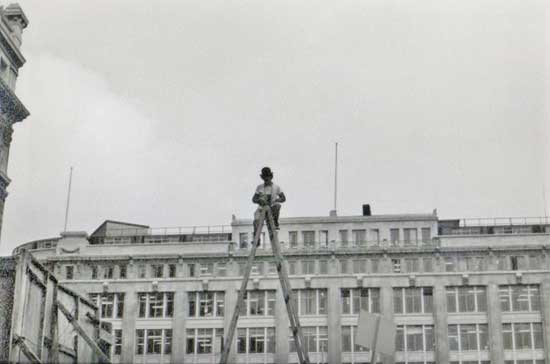 Dashing archaeologist/photographer Ken Dash resplendent in a bowler hat on GPO Newgate Street in 1975. Photo: Ken Dash
Dashing archaeologist/photographer Ken Dash resplendent in a bowler hat on GPO Newgate Street in 1975. Photo: Ken Dash
In not dissimilar vein is a photo taken at Bridewell Palace (BRI78) in 1978, which shows a fearless Trevor Hurst standing on the platform at the top of a big step-ladder preparing to swallow-dive into a loose pile of spoil, whilst killing time waiting for a photo clean to be completed to his exacting standards on one of the palace walls below.
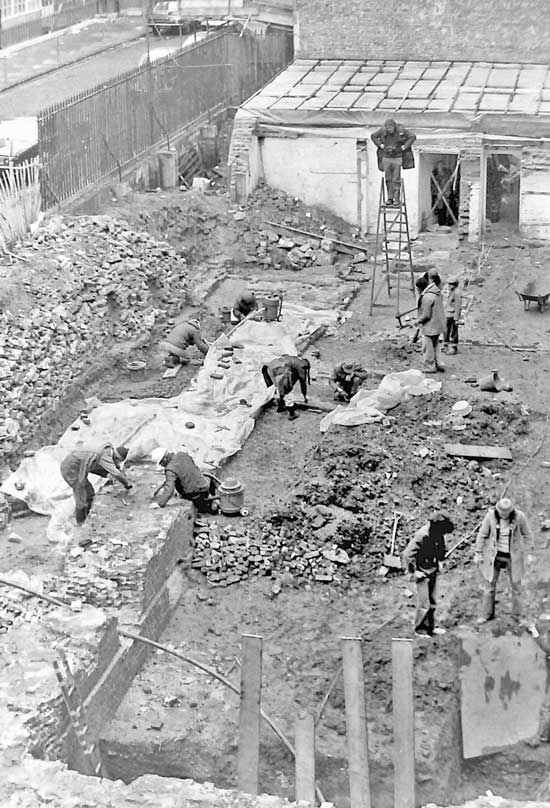 Photographer Trevor Hurst about to take the plunge on Bridewell Palace in 1978, with Ian Blair and supervisor Derek Gadd at bottom right vainly attempting to levitate a shovelling board using mind power alone. Photo: Lez Watson
Photographer Trevor Hurst about to take the plunge on Bridewell Palace in 1978, with Ian Blair and supervisor Derek Gadd at bottom right vainly attempting to levitate a shovelling board using mind power alone. Photo: Lez Watson

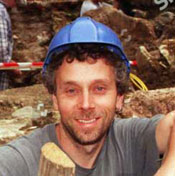

Comments powered by CComment